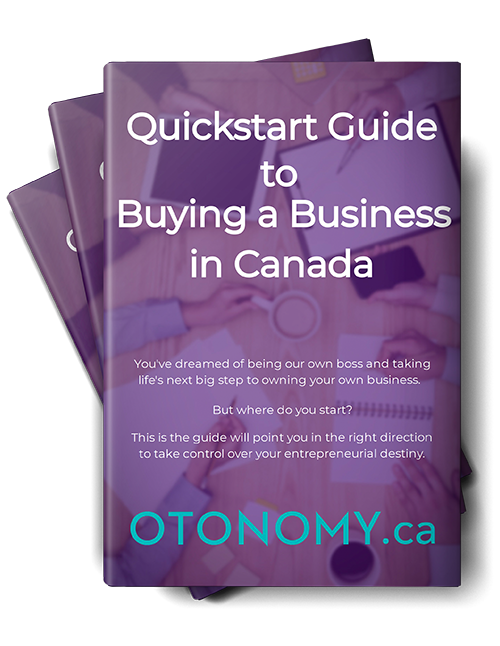I was having a coffee with a friend the other day (true story… I have friends) and he started talking about wanting to buy a small business. He had only just started his search but wanted to bring my attention to a fitness centre he was interested in. He felt the price was reasonable but what really impressed him was how high the “Seller’s Discretionary Earnings” were.
“I can’t believe the owner pays themselves that much!”, he exclaimed. “They must have a tonne of clients.”
It’s possible the fitness centre is doing incredible business. Without doing more due diligence, I have no idea. But I tried to explain that the Seller’s Discretionary Earnings isn’t necessarily the owner’s paycheck. It’s the annual earnings the business brings in that the seller (or owner) can use at their discretion.
My friend went silent. Then looked confused. Then drank his coffee…

So begins the look at a business’s discretionary earnings.
Before we jump into the details of “Seller’s Discretionary Earnings” or “SDE”, we need to talk about something equally important. Small business valuation. How do you value a small business? Profit is one of the most important considerations in the valuation of a business. If the business is making money, you’re off to a good start.
However, like most things in life, understanding what ‘profit’ really means and how it can help both buyers and sellers in understanding what a company is worth, can be somewhat confusing. But fear not! It’s not nearly as complicated as it may seem.
It is important to note that “profit” can be called different things which may have slightly different meanings. You may hear people use terms such as… earnings, EBITDA, cash flow and adjusted net profit as well as others. Basically, they are different ways to help owners, investors, and buyers create a level playing field for determining the value of a business.
Let’s take a look at how this works…
Why Should You Care About SDE?
As the owner of a small to medium-sized business, it is important for you to have a good understanding of your SDE and how these numbers are calculated. Analyzing your Seller’s Discretionary Earnings can help you determine the value of your business. It will be looked at closely by potential buyers when examining your business for purchase. By performing this review, you will have a better understanding of the true earnings of your business, an accurate picture of its worth, and probably most importantly, insight on how to improve its value moving forward.
As you can see, these are very important pieces of data to have before getting into the negotiation of selling your business to potential buyers. Calculating the SDE can help you, as the seller, determine what expenses to include and how those choices affect the business’ valuation.
Similar to EBITDA (which we will discuss shortly), the SDE creates a basis for measurement that can create a level playing field when comparing the value of multiple businesses.
Without getting too far into the math, let’s look at a very simplified example.
Company A has earnings (net income) of $100,000.
Company B has earnings (net income) of $200,000.
If you only considered earnings as a basis for valuation, you would believe that Company B is worth more. However, after some due diligence, you soon find that Company A provides an annual salary to its owner of $300,000. And Company B pays out $50,000 to its owner over the same period.
In this example, which company would be valued higher?
If you said Company A, you would be correct.
When you add back the $300,000 of owner salary to the earnings of Company A, you would have an SDE of $400,000.
Likewise, when you add back the $50,000 to Company B earnings, you would have an SDE of $250,000.
This is obviously an oversimplification for the purpose of explanation. The important takeaway is that the SDE is a calculation of the total financial benefit the current owner receives from the business. It is how much money the owner can earn in one year including many of the benefits owners will often pull out from the business.
There is more to the SDE calculation however which we will take a look at next.

How Do You Calculate Seller’s Discretionary Earnings?
As previously mentioned, the Seller’s Discretionary Earnings is calculated in part by adding the owner’s compensation back into Net Income. However, it goes further than that as there are other items that must also get added back into Net Earnings to get a clearer picture.
In an earlier article, we looked at EBITDA. For a quick reminder, EBITDA is Earnings Before Interest, Taxes, Depreciation and Amortization.
EBITDA = Net Earnings + Interest (on loans) + Depreciation + Amortization
EBITDA is one way to evaluate a company’s earnings without the influence of financial variables like interest on loans, government taxes, depreciation expenses on tangible assets and amortized expenses on intangible assets. It provides the investor with an idea of the overall financial return they will get once they invest in or acquire a business.
EBITDA is a common measurement used by larger businesses that do not have a single owner-operator. If you would like to learn more about EBITDA (and who wouldn’t), we recommend you take a quick read of Otonomy’s recent EBITA article which can be found here {https://otonomy.ca/what-is-ebitda-for-small-business/}
If we include Owner Compensation to the equation, we have the Seller’s Discretionary Earnings.
SDE = EBITDA + Owner Compensation
The trick here is to determine what goes into “Owner Compensation”.
While EBITDA is used to evaluate mid to large companies, SDE is better for evaluating small businesses where there is a single owner/operator.
Owner Compensation or Discretionary Earnings
Discretionary earnings (or expenses) are ones that the business pays for but primarily benefits the owner. Typical categories of these expenses can be the owner’s medical or life insurance, travel, automobiles, meals and entertainment, and dues and memberships. These items exist because owners desire the “tax advantage” of deducting them. They also desire the benefit of re-inserting them into earnings when it comes time to appraise and sell the company.
To qualify as a discretionary expense, they much check all four of these boxes:
- Benefit the owner
- Not benefit the business or the employees
- Paid for by the business and expensed on tax returns and show on the P&L (profit & loss statement)
- Be documented and verifiable by a prospective buyer as discretionary
The 4th item on the list is should prevent owners from going overboard in what they would like to declare as a discretionary expense however, regardless of how conservative the owner/operator is of their accounting procedures, debate will always arise as to what is considered legitimate between the buyer and the seller.
Remember, the seller is looking to increase the SDE to inflate the value of the company while a buyer is looking to reduce this number to lower the price.
Buyer Due Diligence
Discretionary expenses are frequently the source of contention between a buyer and seller. Buyers, understandably, are sceptical of what the seller is passing off as discretionary expenses as that will drive up the SDE and thus the valuation (discussed later when we discuss the fun of multipliers). Even if a buyer agrees with some of these expense items that impact the SDE, they may not be accepted by a bank. It would benefit the seller substantially to stop mixing business and personal expenses at least three years prior to listing the business for sale.
One-Time Expenses are another item that plays into the calculation of the SDE.
One-time purchases are non-recurring costs that are only paid once. Payments for website design services, the acquisition of a company license, one-time application costs, legal fees, and so on are examples of these types of expenses.
Where this comes into question for buyers and why performing due diligence is so important, is to question whether these really were one time expenses or could they come up again. If there is a chance that they may come up again, then technically, they shouldn’t be added to the Net Income to calculate a higher SDE.
When it comes to the acquisition of a company, it’s understandable that buyers are primarily concerned with risk. They question what they don’t know and are concerned that they are not receiving all of the information they need to make a sound choice when purchasing a business. For the owner, if the primary goal to successfully exit the business, they need to lower the perceived risk for buyers. One of the best ways to do this is to consider the line items that go into the SDE. The more questionable expenses the seller uses to calculate the SDE, the greater the chance the buyer will simply walk away.
The cleaner the business financials, the greater probability a deal that works for both the seller and buyer will be reached.
How to Determine Valuation Based on the SDE
Now that we understand what Seller’s Discretionary Earnings are and how to calculate them, the last question we need to answer is “how does number help us determine the selling price or valuation of a business?”
Great question!
To very quickly recap, we’ve taken the Net Income for the business and added back EBITDA and non-essential expenses (one-time expenses, discretionary expenses, owner compensation). This has given us our SDE. Or, how much money the new owner will have to play with once all the required expenses are taken care of.
A common way to value a company, or establish an asking price, is to implement an Industry Multiplier.

SDE Multiple
The industry multiplier is a number business owners multiply their SDE by in order to calculate the fair market value of the business.
Business appraisers take many factors into account when determining industry multipliers, including:
- The size of the business
- Trends in the same market
- The specific industry or type of business
- The business’s tangible assets (real estate, equipment, cash) and intangible assets (client list, intellectual property)
- The value derived from the company brand or the skills the owner or employees bring to the business
- Other variables
The reason for using a multiplier is because it addresses the long term value of a business.
SDE by itself gives the Seller’s Discretionary Earnings for the one year it is calculated. Even if it is averaged that out over multiple years (and you should look at the SDE year of year trend), it still doesn’t take into consideration future earnings. This is why a multiplier is introduced.
Another reason is due to the determinations listed above. Not all businesses are created equal.
For example, two companies may coincidentally have the same SDE. However, one business may be in printed newspaper circulation and the other in web development technology. The tech company may have a much higher multiplier because it sits in an industry showing a strong upward trend.
You can speak with a specialist who handles valuations to get an idea of what multiplier you should use in your business. There are also guides you can purchase that can get you started as you do your own research.
SDE Multipliers can be an effective way in how owners approach setting the price for their small business.
Quick FAQs
What is Seller’s Discretionary Earnings?
Definition of Seller’s Discretionary Earnings Seller’s Discretionary Earnings is a measure computed for a small to mid-size business that takes its earnings and adds back interest, taxes, depreciation, and other adjustments to show the entire financial benefit provided to one full-time owner-operator.
What is EBITDA?
EBITDA is Earnings Before Interest, Tax, Depreciation, and Amortization. It represents a company’s profits before any of these net deductions are made.
What Is Non-Related Income and Expense?
Income and expenses which are unrelated to the core operations of the business.
What are non-cash expenses?
Noncash items in accounting are financial items such as depreciation and amortization that are included in a company’s net income but have no effect on cash flow. While these costs may not have an influence on the business’s net cash flow, they do have an impact on the income statement’s bottom line and result in reduced reported earnings.
What are one-time purchases?
One-time purchases include expenses that are non-recurring and are only paid once.
What are the items that can be added to net income?
Items that are added to net income to calculate SDE include:
- The total salary of all owners
- Any perks you or other owners receive (like personal travel or personal vehicle payments)
- Non-essential positions held by family members.
- Non-cash expenses such as depreciation and amortization
- Leisure activities tied to business activities, such as business golf outings
- Charitable donations on behalf of the organization
- Personal expenses, like the purchase of a personal vehicle, that were claimed against the business tax return
- Any Business trip or travel expense essential to running the business
- One-time expenses that are unlikely to recur after the sale of the business, such as the settlement of a lawsuit
How do I calculate the value of my business using the SDE?
You can calculate the value of your business manually by taking the Seller’s Discretionary Earnings (SDE) and applying an industry multiple. The challenge is understanding what goes into establishing a realistic multiple.
What is an average SDE multiple?
Businesses typically sell for somewhere between one and four times their SDE.
The Bottom Line Summary
The Seller’s Discretionary Earnings (SDE) is a valuation tool that helps the owner of a small business understand how much their company is worth. SDE can be used for mid-sized businesses but is better suited for the valuation of small businesses where the company has a single owner/operator. SDE is also an important consideration during due diligence from buyers as they will want to closely examine the seller’s discretionary expenses and one-time expenses. If your goal is to execute on a successful sale, it would be to your advantage to keep clean, well-documented finance records. Experts advise that owners should start to separate their ‘personal’ expenses from the company’s 3 years prior to sale.
When it comes to determining an asking price, sellers can use SDE multipliers. As not all businesses are created equal, there are multiple variables that go into determining the appropriate multiplier so it never hurts to seek out advice from an expert in small business valuations.
And of course, when you’re ready to sell your business, add your SDE to your Otonomy.ca listing and start engaging with potential buyers. List your business on Otonomy.ca today risk-free with no commitment.




